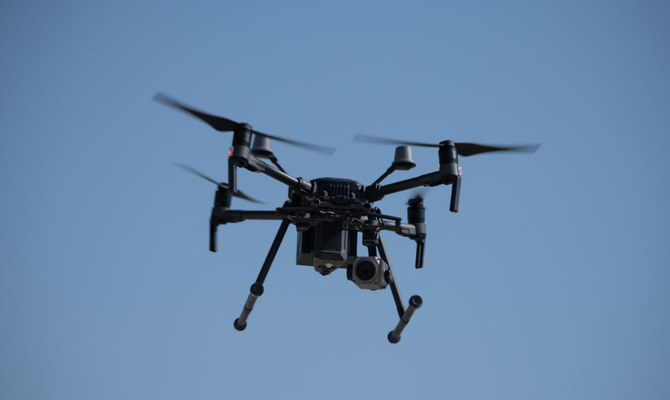Why drones in the desert are helping support biodiversity goals

https://arab.news/yhp5y
Biodiversity — the plant and animal life around us — is often taken for granted. But according to the Intergovernmental Science-Policy Platform on Biodiversity and Ecosystem Services, billions of people depend on wild species for ecosystem services or the many direct and indirect benefits nature provides to humanity.
These benefits fall into four categories: provisioning services such as food and water; regulating services such as climate change resilience, pollution control and carbon dioxide sequestration; supporting services such as shelter and pollination; and cultural services such as recreation, tourism and well-being.
In fact, the International Finance Corp. states that biodiversity is “a fundamental component of long-term business survival,” with enterprises relying on “genes, species and ecosystem services as critical inputs into their production processes.”
Yet it is estimated that up to $5 trillion a year in ecosystem services is lost because of changes in land and sea use, overexploitation of natural resources, climate change, pollution and the spread of invasive species.
Land degradation has reduced productivity in almost a quarter of global land. Between $235 billion and $577 billion worth of annual global food production is at risk due to pollinator loss, according to IPBES.
Moreover, the loss of coastal habitats and coral reefs reduces coastal protection, which increases the risk of floods and hurricanes to life and property for the 100 million to 300 million people living within coastal 100-year flood zones.
At the same time, the Swiss Re Institute notes that 55 percent of global gross domestic product depends on healthy biodiversity and ecosystem services — and that ecosystem collapse threatens a fifth of countries worldwide.
Net positive impact
Saudi Arabia — where Aramco is headquartered — is one of the parties to the UN Convention on Biological Diversity, an international agreement to conserve nature and sustainably use natural resources.
CBD parties recently participated in the 2022 UN Biodiversity Conference in Montreal, Canada, where governments worldwide agreed upon critical actions needed to address “the dangerous loss of biodiversity and restoring natural ecosystems.”
The parties adopted the historic Kunming-Montreal Global Biodiversity Framework, setting out four broad nature protection goals and 23 more specific targets to achieve by 2030.
The UN Environment Program noted that the GBF is crucial to “secure our health and well-being alongside that of the planet.”
It’s clear from the outcomes of the UN Biodiversity Conference that protecting biodiversity is imperative. We all have an essential role, from individuals to communities — and from global corporations to governments. The question is not whether companies should do more to protect biodiversity but how they can be most effective.
It is a challenge Aramco is attempting to tackle head-on by aiming to protect, preserve and restore valuable biodiversity in the places we operate.
One way for companies to act is to enshrine biodiversity conservation into their business models. At Aramco, for instance, we have adopted a Biodiversity Protection Policy that aims to ensure all operational areas have a net positive impact on biodiversity.
Another way is to harness the latest scientific advances and technologies. For example, Aramco uses drones to distribute tree seeds in one of the world’s largest desert oases to protect it from desertification — and advances in digital technology help us monitor the trees’ progress. Meanwhile, we utilize Geographic Information System technology to map and observe wildlife, helping determine areas of high biodiversity value to support decision-making.
Biodiversity in the desert
You may wonder why biodiversity is so important to Aramco. To the outside world, Saudi Arabia is a land of desert sands and barren landscapes. Yet the Kingdom hosts a wide range of very different habitats home to many plant and animal species.
In fact, an astonishing array of biodiversity exists in Saudi Arabia, including over 2,400 species of plants, 1,230 species of fish and 266 species of coral — not to mention the Kingdom’s 117 species of mammals and 107 species of reptiles.
Saudi Arabia’s deserts have unique ecosystems of highly adapted plants and animals. There are also marine and coastal ecosystems along the Red Sea and the Arabian Gulf, as well as valley and mountain region ecosystems. These are all home to amazing wildlife, including the Arabian leopard, the Nubian ibex and approximately 500 bird species.
But as in other parts of the world, many of these species are under threat — around a third are formally listed as threatened with extinction. Moreover, populations of 70 percent of these species are decreasing.
Practical solutions
In our experience, one of the effective ways to attempt to restore habitats — providing benefits for people and wildlife — is to remove pressures such as grazing and overexploitation.
Another is to reestablish plant communities that were lost. One example of this is our work in trying to restore mangrove forests that thrive in the salty waters and extreme temperatures of the Arabian Peninsula.
Studies suggest mangrove forests are effective carbon sinks, potentially storing up to five times more carbon dioxide than tropical rainforests, absorbing it faster and retaining it for much longer than terrestrial trees.
They also stabilize coastlines, filter out pollutants and provide habitats for several marine species and migratory birds. Therefore, we have planted over 13 million mangrove seedlings around Saudi Arabia under the Saudi Green Initiative, which aims to plant 10 billion native trees across the Kingdom over the coming decades.
Identifying and protecting essential wildlife areas can also help protect fragile habitats. So far, Aramco has designated 12 Corporate Biodiversity Protection Areas covering almost 1,000 square kilometers of diverse ecosystems, including wetlands, deserts, mountains and marine habitats. In addition, we are expanding these protection efforts to other important wildlife sites.
One of our most fragile ecosystems is the coral reef. Coral reefs are marine biodiversity hot spots and provide enormous ecological resources, often crucial to the coastal economy. They are home to numerous marine species and help reduce coastal erosion.
But they are under threat from the effects of climate change, and sea temperature rises have led to coral bleaching. However, we identified areas in the Arabian Gulf that are less susceptible to sea temperature rises. We installed 40 artificial reefs in these areas to safeguard the critical ecosystem services they provide.
Protecting and preserving biodiversity will remain part of our company strategy. It is vital to our continued success and ambition to be responsible global corporate citizens. We have the scale, resources and influence to contribute to the broader development of more sustainable solutions that aim to safeguard biodiverse ecosystems for future generations. It is a cause that the private sector cannot afford to ignore.
• Mohammed Alhajri is general supervisor in Aramco’s Environmental Biodiversity Division.











































